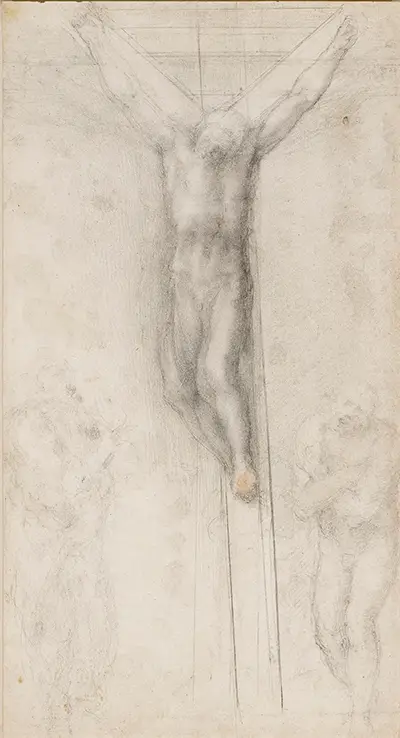Hundreds, if not thousands of Michelangelo's study drawings would have been lost or damaged during his own lifetime and in the centuries that have passed since, but despite that, many still exist for us to enjoy and learn from. He may have been arrogant in nature, but he never forgot the importance of practice in order to master his craft and drawing laid the foundation for everything that he produced within his lifetime. As a student, his first lessons would always be within this art form, just as they would across Europe for many centuries afterwards. Another version of this drawing exists which is very similar to the one found here. It was titled Christ on the Cross between the Virgin and St John. The main difference between the two is that the standing figures in this drawing are much less complete and Christ is angled slightly differently.
The lack of detail on the Virgin and St John mean that we must seek other sources of information on the artist in order to first identify them and then discuss how they would have looked had the sketch been developed further. The cross itself is limited to just two single lines, and Michelangelo has clearly changed the angle as we can see fainter lines from a previous base of the cross which was originally much straighter. The same can also be said for the higher part of the cross as well, with several different ideas identified in this drawing. The area that is developed to a much greater degree would be Christ himself, with all but his arms being well crafted, with shadow and contours all present. With a similar version available, it may be that this drawing was constructed first, with the next one being the other, as he added detail to both the Virgin and St John, feeling more confident on the angles and postures of each figure.
Black chalk was used to create most of this scene, and it was the tool of choice for most Renaissance draughtsman, though they would sometimes swap for alternative colours, with red being popular for portraits. White heightening is then added over the top in order to create a feeling of light on the surfaces of the figures. Many of the principles used by Renaissance draughtsmen would still be taught today as best practice, and art students will use the work of the great masters as a starting point from which to learn the key techniques of this challenging but rewarding artistic discipline. Michelangelo also produced a wooden sculpture titled, Crucifix and would frequently tackle the same topics from a variety of mediums. In some cases these would be commissioned requests, but on other occasions he would simply be preparing first in chalk for a later painting or sculpture. Both drawings are to be found in the Royal Collection in the UK, where a wealth of Renaissance drawings can be found, expertly preserved and protected for future generations to enjoy. The collection is sometimes overshadowed by other major art galleries and museums found in London, but those with a passion for this period of art should take note of this impressive venue.


